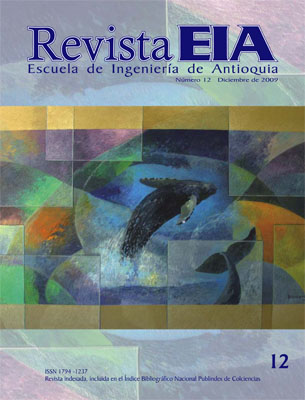DEGRADABILIDAD DE UN POLÍMERO DE ALMIDÓN DE YUCA (DEGRADABILITY OF A TAPIOCA STARCH POLYMER)
DEGRADABILIDAD DE UN POLÍMERO DE ALMIDÓN DE YUCA (DEGRADABILITY OF A TAPIOCA STARCH POLYMER)


This work is licensed under a Creative Commons Attribution-NonCommercial-NoDerivatives 4.0 International License.
Copyright statement
The authors exclusively assign to the Universidad EIA, with the power to assign to third parties, all the exploitation rights that derive from the works that are accepted for publication in the Revista EIA, as well as in any product derived from it and, in in particular, those of reproduction, distribution, public communication (including interactive making available) and transformation (including adaptation, modification and, where appropriate, translation), for all types of exploitation (by way of example and not limitation : in paper, electronic, online, computer or audiovisual format, as well as in any other format, even for promotional or advertising purposes and / or for the production of derivative products), for a worldwide territorial scope and for the entire duration of the rights provided for in the current published text of the Intellectual Property Law. This assignment will be made by the authors without the right to any type of remuneration or compensation.
Consequently, the author may not publish or disseminate the works that are selected for publication in the Revista EIA, neither totally nor partially, nor authorize their publication to third parties, without the prior express authorization, requested and granted in writing, from the Univeridad EIA.
Show authors biography
El uso de materiales poliméricos se ha incrementado debido a sus buenas propiedades y bajo costo, como resultado, la cantidad de estos materiales que llega a los rellenos sanitarios ha aumentado hasta llegar hoy en día al 30 %. Como una solución a este problema, se han desarrollado los polímeros biodegradables, que en comparación con los sintéticos son degradados en el ambiente al ser expuestos a ciertas condiciones en un tiempo más corto. En esta investigación se estudia la degradabilidad de un polímero fabricado con almidón de yuca, para esto se hace una caracterización del material y se somete a diferentes medios como agua dulce y salada, luz solar y la simulación de un relleno sanitario por varios períodos. Para determinar la degradabilidad del material se midió el porcentaje de mineralización, así como cambios en las propiedades mecánicas, morfología superficial, absorbancia en IR y pérdida de peso, dependiendo del tipo de medio. De los resultados obtenidos se encontró que el polímero es degradado al estar sometido a la simulación de relleno sanitario, agua salada y, en menor medida, a la luz solar, en tanto que en el agua dulce el polímero no se degrada.
Abstract: The use of polymeric materials has been increased due to their good properties and low cost. As a result, the amount of plastic that gets to landfills has increased until 30 %. As a solution to this problem, biodegradable polymers have been developed; and compared to synthetic polymers, they are degraded in the environment when exposed to certain conditions in a shorter period. One of the raw materials that is widely used in the manufacturing of biodegradable materials is starch. In this research study, the biodegradability of a polymer made of tapioca starch has been studied. To determine this, the polymer has been characterized and exposed to salt and fresh water, sunlight and a simulation of a landfill for a series of periods. To determine its biodegradability, percentage of mineralization was measured as well as changes in tensile properties, superficial morphology, IR absorption and weight loss depending on the type of environment. From the results it was found that the polymer is degraded by being subjected to simulated landfill, salt water and to a lesser extent in sunlight, while in fresh water it does not get degraded.
Article visits 357 | PDF visits 199
